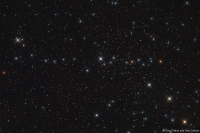The Parker/Carboni deep-sky imaging machine has just produced another starry work of art for your enjoyment. This time it is the famous Kemble’s Cascade asterism in that well-known constellation Camelopardalis.
In 1980 (yes as late as that!) Lucian J. Kemble told Walter Scott Houston (see “Deep-Sky Wonders” in the books list) about a grouping of stars he had discovered. Using 7 x 35 binoculars Kemble had found a cascade of stars in Camelopardalis that ended up on a little open cluster – NGC1502. Houston called this asterism Kemble’s Cascade and the name stuck. It is strange that the asterism does not show up on starmaps or planetarium programs, but clearly stands out when viewed through low-power binoculars. It also takes some processing effort (as Noel will attest) to make the asterism appear in CCD data. Clearly the eye-brain system applies some subtle contrast-enhancing wetware that non-discriminating cameras and photometric equipment do not apply! This is not as strange, or unique as you might imagine.
Take a pair of low-power binoculars, 10 x 50 are fine, and look at the Double Cluster in Perseus. You will see an amazing ring of stars looking like a bracelet. The Double Cluster is linked to the bracelet like a charm attached to a charm bracelet. Now look at the same region of space on a star map or planetarium program – no bracelet. Take a wide field CCD image of the region, the bracelet is barely distinguishable – yet go back to the binoculars again and it clearly stands out against all the background stars in the area. Most strange!


